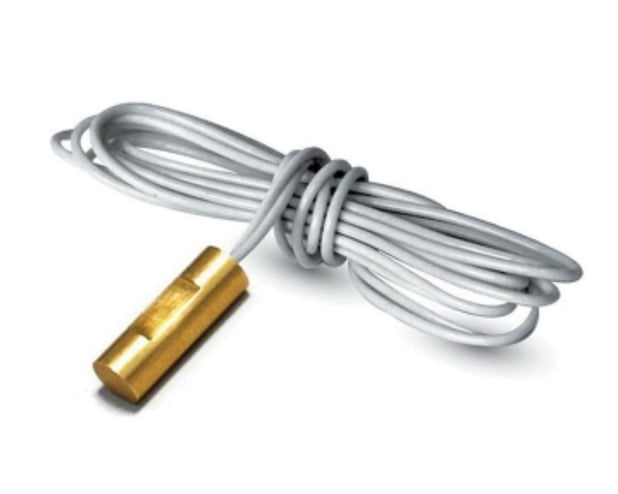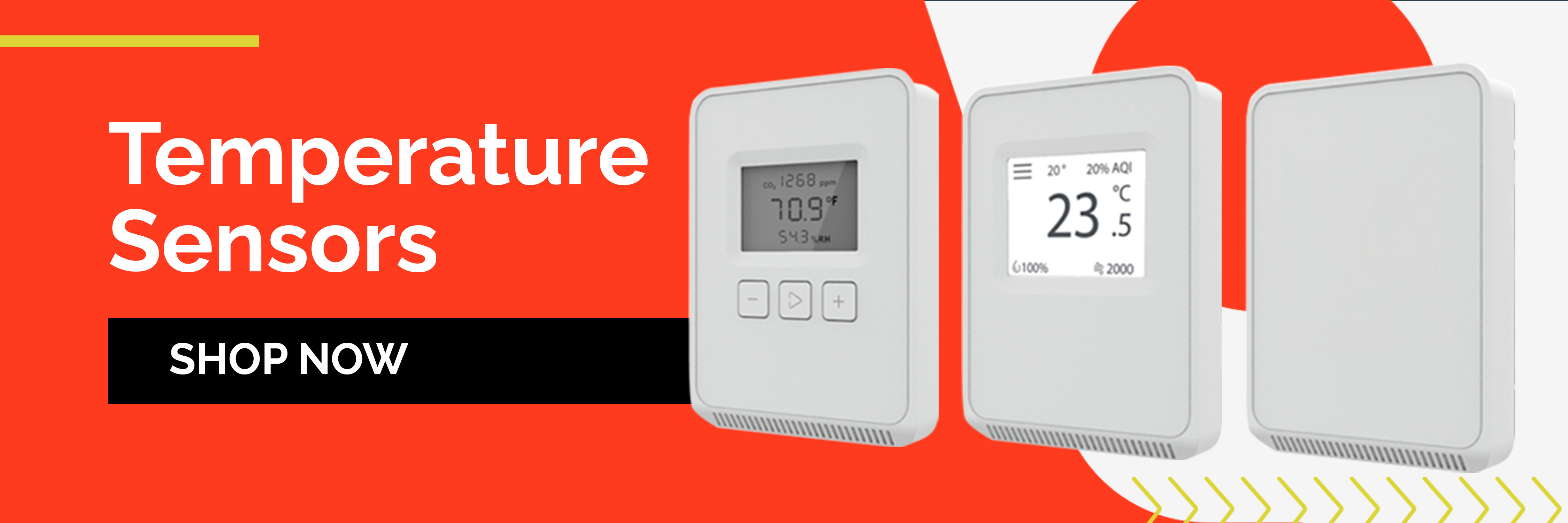What is a Temperature Sensor? | Veris Industries

What is a Temperature Sensor?
Temperature sensors are devices that detect and then quantify the temperature of their environment. Glass tube thermometers are a simple example. Modern temperature sensors, however, are electronic devices that convert the raw environmental input (the temperature reading) into electronic data, which can then be transmitted to a remote electronic display or interpreted by software and building automation systems.
The purpose of a temperature sensor is to record, monitor, and trend temperature changes. Sensors can also be used to trigger other systems in response to set temperature parameters. For example, activating heating or cooling systems or adjusting fan speeds or outside ventilation. These functions make temperature sensors a cornerstone of modern HVAC and building management systems.
Temperature Sensor vs Humidity Sensor: What’s the Difference?
Humidity is often associated with hot weather and can be confused with temperature. After all, hot, humid air makes for an uncomfortable indoor environment. However, humidity is separate from temperature.
- Humidity sensors (hygrometers) measure and report the level of moisture in the air. This is generally measured in one of two ways. “Absolute humidity” is a measure of the total quantity of water vapor in the air, whereas “relative humidity” is a measure of the percentage of water in the air compared to the maximum possible (at the current temperature). High relative humidity can impact our perception of temperature, making air seem hotter or colder than it really is.
- Temperature sensors measure the actual air temperature, regardless of humidity. It’s possible to have a hot interior space that is perfectly dry (a common occurrence when the heat is blasting in the winter), or a cold interior space that is very humid (a frequent problem in basements that can lead to mold issues).
Both types of sensors can help to improve IAQ, since both temperature and humidity will impact the occupants’ overall level of comfort. They protect against different threats, though. Watching humidity can help you to prevent mold and mildew growth or to maintain environments sensitive to wet/dry air (like libraries, zoos, laboratories, or print shops). Temperature is more important for maintaining cold storage, preventing overheating in data centers, and other applications where heat or cold can cause trouble.
Ideally, your temperature sensor will also include a humidity sensor, so that you can track both!
What are Temperature Sensors Used For?
Temperature sensors are used to measure temperature in many different applications and industries. Here are some examples of industries and applications that make use of temperature sensors:
- Industrial: Forges, steel mills, manufacturing plants, and many other industrial environments need to keep an eye on the temperature of their materials, equipment, and the ambient air inside the structure.
- Scientific and laboratory: Lab environments can be highly sensitive to temperature, as many materials must be stored or used within certain temperature conditions to maintain their effectiveness, safety, and reliability.
- Medical: Temperature is critical to the comfort of patients in medical facilities, but also to safety and compliance. Hospital ORs, for example, need to run cold to combat bacteria and viral growth.
- Domestic appliances: Appliances are intended to operate within a certain temperature range for optimum performance. It’s possible for many appliances to malfunction or break if they overheat. Internal sensors might auto-shutoff an appliance, but you can also deploy room temperature sensors in laundromats, kitchens, hair salons, and other appliance-heavy structures to watch for problematic ambient temperature levels.
- Technology: As with appliances, technology centers and data warehouses must watch temperature closely to ensure that computers and data-processing equipment, which generate a lot of heat, are properly cooled and ventilated.
- HVAC: Temperature sensors are one of the key components of most HVAC systems, because they detect environmental temperatures and use the readings to trigger building equipment when certain parameters are met.
- Transit: The enclosed environment of transit structures like subways make it necessary to track air quality and temperature so that it can be regulated to maintain comfort — even when freezing or sweltering outside air is always flowing through open stairways and becoming trapped inside.
What are the Different Types of Temperature Sensors?
There are a wide variety of temperature sensor types, each used for different purposes and temperature ranges. Here’s a small list of some examples:
Thermostat Temperature Sensors: A thermostat is a simple wall temperature sensor or indoor temperature sensor, used to keep a building compliant and occupants comfortable. These are among the most common and widely used temperature sensor types in building operations.
Thermistor Sensors: ThermaIly sensitive resistors, or “thermistors,” are accurate and cost-efficient temperature sensors. Used in many commercial and industrial applications, a thermistor is often sheathed in a protective probe (which can be easily sanitized) then put to use in the food and beverage industry, science labs, R&D, and other applications where a sensor for surfaces, liquids, and ambient gasses is useful.
Thermocouples: A thermocouple consists of two wires (with different metals) joined at one end, and connected to a thermometer. Touching the wires to a surface will heat them each at a different rate, since they’re different metals, and that difference helps the device calculate the exact temperature of the surface. They’re often used in industrial applications for detecting high temperatures on equipment, hot metal, or other hot surfaces.
Resistive Temperature Detectors (RTD): An RTD temperature sensor is a passive temperature sensing device that experiences increased resistance as its temperature increases. RTDs are very stable and more accurate and linear than thermistors or thermocouples. However, they’re also slower and more expensive. These are slowly replacing thermocouples in applications below 600 degrees Celsius.
Negative Temperature Coefficient (NTC) Thermistor: This is the most common type of thermistor, a highly sensitive temperature sensor that’s often rather small. Unlike an RTD, the resistance in a negative temperature coefficient thermistor will decrease as the temperature increases. NTC Thermistors are often used in room sensors, medical applications, patient monitoring, computing and communications equipment, and other applications as a cheap, high accuracy temperature sensor that’s ideal for use within a narrow temperature range.
3 Benefits of Temperature Sensors
1. Temperature Sensors are Affordable and Extremely Reliable
Temperature sensing technology has been around for a long time and has been perfected to impressive levels of accuracy and specificity. Not only that, but the technology needed to create an extremely reliable temperature sensor is highly affordable. There’s little reason to overlook the installation of temperature sensors in our smart modern buildings where these cost-effective little workhorses can make a huge difference.
2. Faster Response Times
People can sense ambient temperatures on their own, and simply rely on their level of comfort to adjust indoor temperatures. However, we’re likely to only realize the temperature is suboptimal once it’s well off the mark. With a temperature sensor, you have a device that’s always watching and this makes it easier to react quickly when temperatures fall outside their optimal range. With automation enabled, it’s even more convenient — you don’t need to do anything because the system corrects itself.
3. Precise Linearity and Low Hysteresis
Linearity is a measure of how much a sensor’s output deviates from the input parameter that is being sensed. More linearity makes it easier to calibrate and minimize uncertainty in its output scaling.
Hysteresis is a measure of how much lag there is between changes in the input (the temperature) and the output (the sensor’s reading). A low level of hysteresis would mean that the sensor is reading temperature changes without much delay, as close to real-time as possible.
High-quality temperature sensors are precise, with excellent linearity and low levels of hysteresis. The sensor’s detected output closely matches the real temperature input and reflects any changes almost immediately.
Choosing the Best Temperature Sensor
When selecting a temperature sensor for use, for whatever reason, you should take the following into consideration:
- Temperature range: Not all temperature sensors are designed to operate at ambient indoor temperatures, and the sensors inside of a room thermostat would be of little use in precisely detecting the temperature of molten metal. Pay close attention to the maximum and minimum temperatures recommended for the sensor before selecting it for your application.
- Accuracy: Without sufficient accuracy, your temperature sensor is of little use. Precision applications must pay close attention to accuracy.
- Stability: This is the ability of the sensor to remain constant over time. Think of it as the durability of the sensor — how much use it can withstand before losing accuracy and needing recalibration.
- Size and Package: The smaller the sensor, the easier it will be to fit within convenient or unobtrusive devices. This naturally matters more in some applications than others. You’ll also want to consider the durability of the packaging, which protects the sensor.
- Noise Immunity: Interference of various kinds can throw off a sensor’s outputs. Interfering electrical signals or noise within wiring can hurt the reliability of a sensor that is wired into a building system. You’ll want sensors that are immune to noise and can operate reliably even when wired over great distances.
Veris has a variety of temperature sensors with smart technology, touch screen displays, and flexible interface configurations that can be packaged to fit your price range. Shop now or contact us today, and we’ll help you find the right temperature sensor for your needs.





